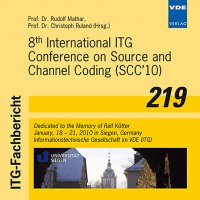Space-Time Bit Trellis Codes
Conference: SCC'10 - 8th International ITG Conference on Source and Channel Coding
01/18/2010 - 01/21/2010 at Siegen, Germany
Proceedings: SCC'10
Pages: 6Language: englishTyp: PDF
Personal VDE Members are entitled to a 10% discount on this title
Authors:
Kienle, Frank; Gimmler, Christina (Microelectronic Systems Design Research Group, University of Kaiserslautern, Erwin-Schroedinger-Strasse, 67663 Kaiserslautern, Germany)
Abstract:
Multiple antenna systems are a promising approach to increase the data rate of wireless communication systems. There exist two main transmission schemes. In BICM systems, modulated symbols are multiplexed on multiple transmission antennas while an outer error correction code ensures the desired quality of service for a given data rate. Space-time trellis codes use a trellis structure to determine the transmission symbols for different antennas. For both schemes, the decoding complexity grows exponentially with the number of antennas and thus the desired code rate. In this paper, we propose the use of space-time bit trellis codes instead which are a concatenation of a bit convolutional code, modulator and spatial multiplexing without interleaving. We present a new near-ML decoding algorithm with an algorithmic complexity which scales only linearly with the number of antennas. This new algorithm can be applied to all schemes where trellis based channel coding is directly followed by modulation and spatial multiplexing.We show simulation results for 16-QAM up to 16x16 transmit/receive antennas with a data rate of 32 bits per channel use. The communications performance lies within 3dB of the outage capacity for a frame error rate of 10(exp ?2). This is to the best of our knowledge the best result reported so far.


